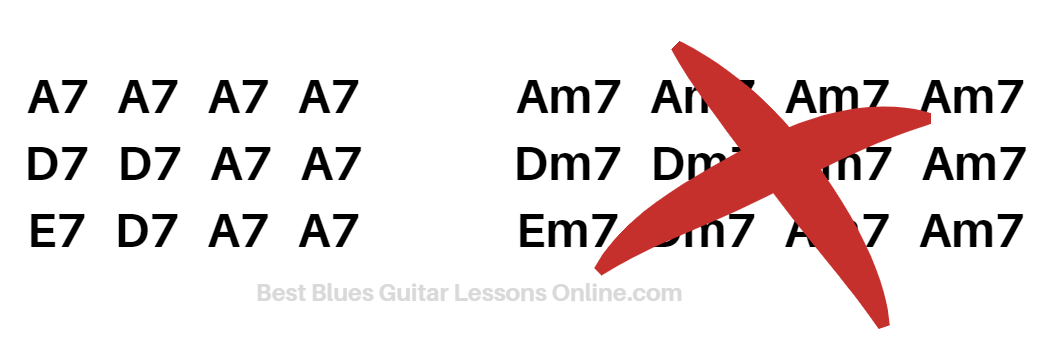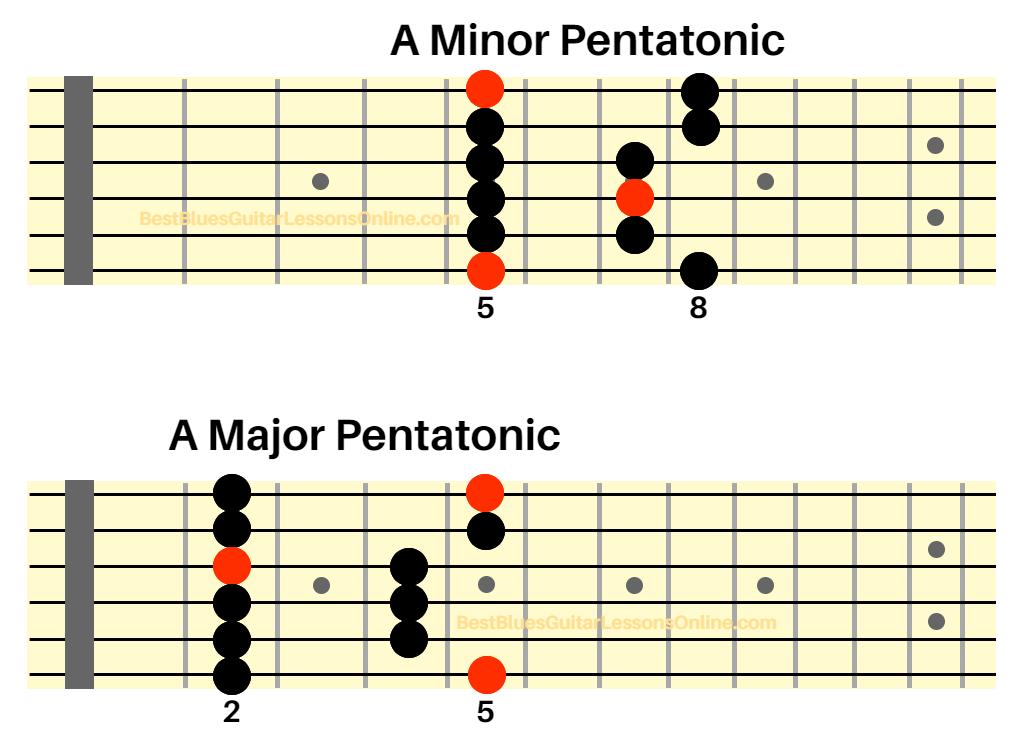Why Your Blues Guitar Soloing Doesn't Sound Anything Like The Solos Of The Best Blues Guitarists
by Antony Reynaert
Remember when you first learned the minor pentatonic scale. You discovered how to improvise on guitar and before you knew it you were playing your own blues guitar licks. As much fun as learning to improvise on guitar in this way is, it’s important that you don’t get stuck in this phase where you are only using the minor pentatonic scale in your soloing. If you improvise using a 12 bar blues progression there are plenty of other options that you can choose from. In this article we are going to look at some of these so you can expand your options when you are playing blues solos.
The Basics: The Minor Pentatonic Scale
Using the minor pentatonic scale to improvise over blues chords is the approach that almost every beginner blues guitar student learns. Yet this approach is only one of the many possible ways we can use and if overused it may appear to the listener that you play the same solo in every song.
Why The Minor Pentatonic Scale Is Not The Best Option To Use
Many intermediate guitarists get stuck playing only the minor pentatonic scale over blues chords. But did you know that the minor pentatonic scale isn’t the best choice to play over a blues chord progression? It’s a fact that some of the notes in this scale will ‘clash’ quite a bit with the dominant seventh chord it’s being played over. This is also the reason why experienced guitarists don’t only rely on this minor pentatonic scale when their soloing in a blues context.
Let’s examine exactly why this minor pentatonic might not be the best option. One of the most important things that music theory will teach you is to spell out the notes in a scale and compare it to the underlying chord. For example, the notes in the A minor pentatonic scale are; A, C, D, E and G. Compare this to the A, C#, E and G note and you will find that the C note from the minor pentatonic scale is not present in the chord. In fact, the C note that is contained in the pentatonic scale will sound pretty harsh against the C# note that is found in the A7 chord.
You can try this out for yourself; play these two notes simultaneously on guitar and notice the dissonance between these two notes. It’s true that the minor pentatonic is the first scale that you’ll learn in blues improvising, but this doesn’t mean that we have to stay stuck only using this scale.
How Professional Blues Guitarists Use The Minor Pentatonic Scale
Let’s look at how professional blues guitarists make use of the minor pentatonic scale to create advanced licks they use in their soloing. It’s a given fact that some guitarists like the dissonance that is cause by playing the C note against the C# note that is in the A7 chord. Still most experienced guitarists will choose to either:
- Not use the minor pentatonic scale at all (that’s the main reason why many beginners on blues guitar improvisation hear that what they play doesn’t sound anything like the licks and solo of their favourite players, but they don’t know that they actually are using different scales).
- Use the minor pentatonic scale but alter some of the notes.
- Use a variety of techniques to alter the C note (if we play the Am pentatonic scale) so this note becomes a ‘passing note’ instead of a ‘target note’.
It’s important that you understand that it’s perfectly legitimate to use the minor pentatonic scale to play over dominant blues chords. It’s just that there are many options that can be explored instead of using only the minor pentatonic scale in your soloing. Having the option to use more advanced scales leads to greater melodic freedom and is a great thing to have in general.
There are so many other scales that can be used in blues guitar soloing that it would be a pitty to only make use of the same scale all of the time. Advanced guitarists don’t use one single scale to play blues solos, but use a combination of many different scales, which makes their sound more advanced and highly personal. So
So let’s look at how you can become more creative with different scales and licks to radically improve your overall blues guitar soloing.
Alternating Between The Major And Minor Pentatonic Scale
One of the options that we can use to add more variation in our blues guitar soloing is to alternate between the minor pentatonic scale and the parallel major pentatonic scale. So if you would solo over a song in the key of A you could use the A minor pentatonic scale as well as the A major pentatonic scale. Here it is important to realize that we can only go for this approach when soloing over a ‘major blues’ (which means we are playing over a blues progression in a major key with dominant 7th-chords, such as A7, D7 and E7). If we would play over a ‘minor blues’-progression (with for instance the chords Am7, Dm7 and Em7) we can’t use this option.
In the chord diagrams below you see both the minor and major pentatonic scale in the key of A. So these scales can be used interchangeably if we play over a ‘Blues in A’ (the term ‘Blues in A’ is used when we are playing a Major Blues in the key of A, when we would play a Minor Blues we speak of a ‘Minor Blues in A’).
Now try this: play a solo over a blues in A backing track en switch back and forth between these two scales. You will notice that even though this sometimes will result in a nice sound, sometimes it will be challenging to create a fluent change between both scales. The change from the minor pentatonic to the major pentatonic scale (and vice versa) will often sound to ‘abrupt’. That’s why we’re going to look at some transitions in which you can combine these two scales.
Creating A Fluent Transition Between The Major And Minor Pentatonic Scale
In the example below we start of in the major pentatonic scale and then transition to the A minor pentatonic scale. Take note of the use of the C#-note in the second measure of this lick. Because we add this note (that originates from the A major pentatonic scale) to the minor pentatonic scale we create a slightly more major pentatonic sound, while still playing in the minor pentatonic scale.
Try to experiment with this way of linking together both scales. Simply start playing a lick in the major pentatonic scale and try to make the transition to the minor pentatonic scale as smooth as possible. Also work the other way around; start with the minor pentatonic scale and try to shift to the major pentatonic scale fluently.
Start to experiment with these approaches in your own guitar playing. You will notice that this way of playing will prove a radical shift in your sound and will spark your creativity. Learning blues guitar licks like the one above and applying them when you're improvising over backing tracks will make your soloing more advanced.
There are many more possibilities that you can learn to expand your options when soloing in the blues:
- Using more advanced guitar scales such as the dominant pentatonic scale and the mixolydian mode to give your soloing a jazzy feel (don’t worry, it’s not as hard as it sounds).
- Using half-step bends to shift from the minor pentatonic scale to the major pentatonic scale.
- Alternating between the major and minor pentatonic scale, but only using one of these two scales on certain chords. For instance, when soloing over a blues in A, you could use the minor pentatonic to play over the D7 chord and play the major pentatonic scale over the other chords. This will result in a melodically more advanced sound.
You can learn all of these approaches with advanced blues licks to practice in the free Blues Guitar Solo Guide On How To Play More Advanced Guitar Solos.





